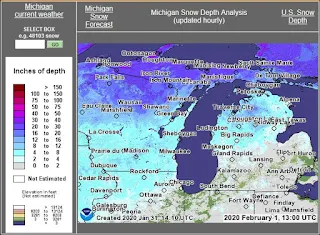Reader JSW recently commented that they recently purchased property in Michigan and expressed an interest in identifying the trees growing on the property.
Then, in a follow-up email, he indicated that his property was approximately three hours from Eaton Rapids AND there was a significant amount of snow on the ground.
Let's see what we can do, sleuthing wise, with the information JSW gave us.
 |
| Link |
We have had much warm weather and there isn't much snow on the ground until you get north of Big Rapids/West Branch
Let's assume JSW's property is in Wexford County since they still have decent snow-pack and it is approximately three hours from Eaton Rapids.
The original soil surveys indicate that most of Wexford County was covered with hardwood forests
The parts that were not covered in hardwoods were "pine plains"
More recent nomenclature for the forests that were originally described in Wexford County are Dry-mesic Northern Forests for the hardwood forests and Dry Northern Forests.
Dry-mesic Northern Forests
White pine (Pinus strobus) is nearly always a dominant or important canopy species within this forest type, often forming a supercanopy above other tree species. Red pine (Pinus resinosa) and hemlock (Tsuga canadensis) are frequently present and occasionally codominant with white pine in the canopy or supercanopy. Hardwood associates include white oak (Quercus alba), black oak (Q. velutina), red oak (Q. rubra), and red maple (Acer rubrum) (The rolling hills in southeast Wexford County have much Sugar Maple, too). Paper birch (Betula papyrifera), aspen (Populus tremuloides and P. grandidentata), and balsam poplar (P. balsamifera) are also common in the overstory. Balsam fir (Abies balsamea) and white spruce (Picea glauca) are often present in the subcanopy, especially in fire-suppressed systems. Source
That gives you three evergreens to key out. The hardwoods will basically fall into three bins, Oaks, Maples and "poplar-like" trees.
Dry Northern Forest
The overstory of dry northern forest is dominated by jack pine (Pinus banksiana) or red pine (P. resinosa). Northern pin oak (Quercus ellipsoidalis) usually accompanies jack pine in the canopy; big-toothed aspen (Populus grandidentata), red maple (Acer rubrum), and paper birch (Betula papyrifera) are typical canopy associates in stands of red pine. Red pine, white pine (P. strobus), and balsam fir (Abies balsamea) often occur in the subcanopy. -Source
One nice thing about both of these forest types is that wild blueberries are often found where the canopy is thin. That is some good eating.
The point
The point is that you can make the task of identifying your species much simpler if you know what you are trying to key out. There is no point in looking for Sycamore or Honey Locust growing wild in Wexford County.
Another simplification is to ask yourself, just how precise do I want to be? Except for professional foresters, most folks are plenty happy to separate oaks into "white oaks" with rounded lobes and "red oaks" with pointy lobes. Trying to identify the various species of "red oaks" will drive you mad.
As a first pass, you can walk through your woods in Wexford County (or nearly any place north-of-the-knuckles in lower Michigan) and separate the trees into Pines (evergreens, needles in bundles), Oak (has acorns, excellent firewood), Maple (look at the Canadian flag), Poplar (leaves shimmy in breeze, grow fast) and Birch (similar to poplar, bark peels easily from trunk, better firewood than poplar) and you will have identified at least 80% of the trees in your woods.
At that point, you will find the occasional tree that doesn't fall into any of those bins. It might be a beech tree or a basswood tree. If so, you are probably on the wetter end of the "Dry-mesic" forest. When you get time, you can key out what the odd-ball trees are...but only if you want to.
Mesic Northern Forests
Dominant tree species of mesic northern forest include sugar maple, American beech, and hemlock. ...sugar maple most frequently dominates the community throughout Michigan... Other important components of the canopy include yellow birch (Betula alleghaniensis), white ash (Fraxinus americana), basswood (Tilia americana), red oak (Quercus rubra), northern white-cedar (Thuja occidentalis), and white pine, which can attain supercanopy status.



You bundled that up nicely. I need to remember that. Being an old man in the country I get the young'uns from the big town buying property here and asking what kind of trees they have. Your technique is most helpful and will make me look smart. thanks--ken
ReplyDeleteThank-you, sir.
DeleteI am not sure that would work everywhere. The sandy plains of northern Michigan is not as richly endowed with species as some other places.
It is helpful that the hand of man passed lightly over it. Unlike the city, there are few non-native species.
Again, thanks.
Well, you basically described my property! Canopy pines are the biggest species. Now I just need to break down the different types of pines and oaks I have. Thanks again! jsw
ReplyDelete